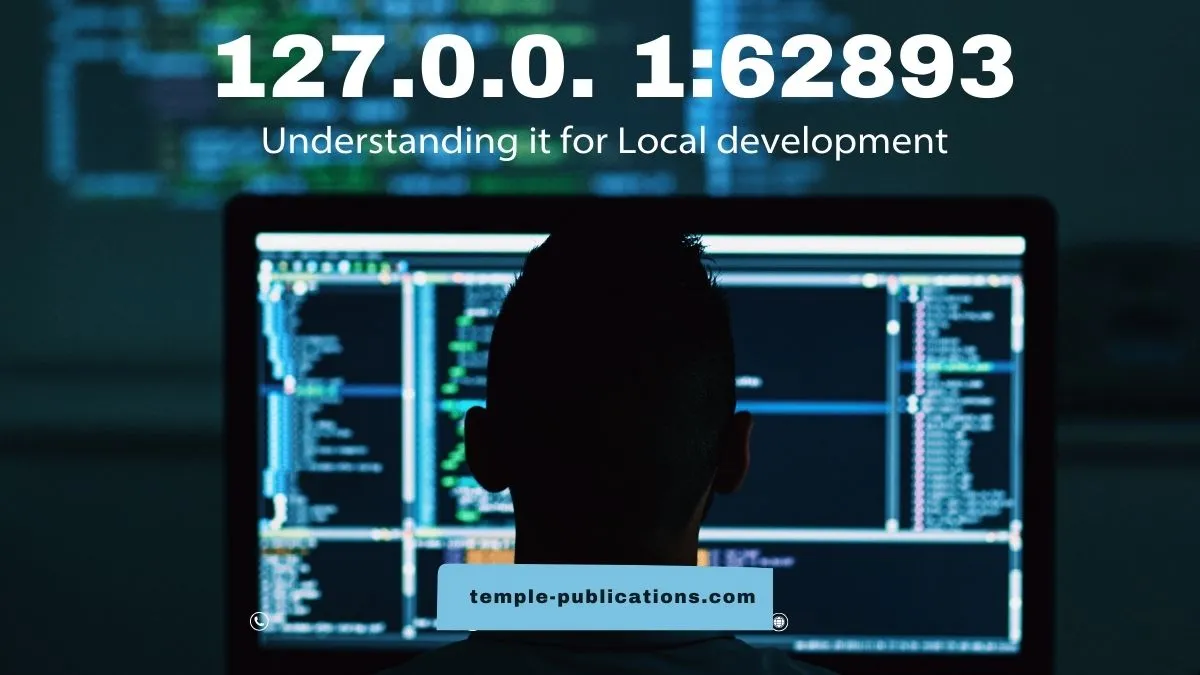TECHNOLOGY
Understanding 127.0.0.1:62893 for Local Development

In software development, practical testing and debugging frequently necessitate dealing with services running locally on your machine. Knowing how local IP addresses and ports work is one of the most essential parts of this process. One of the most familiar addresses used for this purpose is 127.0.0.1:62893. But what does it mean precisely? Is it essential for local development? In this article, we will elaborate on 127.0.0.1:62893, break it down, and demonstrate how it fits in the big picture of the local environment of development, debugging, and testing.
What is 127.0.0.1:62893?
From an outside point of view, 127.0.0.1 is a loopback address, meaning the localhost, while 62893 is dynamically assigned. Combined, they provide a local destination for services running on your machine. This knowledge will drastically change how you configure and debug local services, and you’ll become more efficient at your Development Workflow. With a local port such as 62893, you’ll have all the power you need to build a web server, database, or API.
The Role of 127.0.0.1 (Localhost) in Networking
To understand the significance of 127.0.0.1:62893, one must first be clear about the loopback address 127.0.0.1. This IP address, which is known as “localhost,” is used for communication between machines within a system; a machine can send data to itself.
In networking, the loopback address redirects traffic to the same device, a function that is important in software development and testing. When sending requests to 127.0.0.1, you are talking to services on your own computer; there is obviously no need for an external network connection.
What Does Port 62893 Mean?
Apart from 127.0.0.1, the Port number = 62893 is important for local networking. Ports are an entryway into directing certain kinds of traffic to the relevant services on a machine. Every running application or service waits on a unique port number to receive incoming data. Ports are essential in the way data is organized and processed in a machine.
Three port numbers exist, namely: |solution|>. There are three types of port numbers: established port (0–1023), registered port (1024–49151), and dynamic or ephemeral ports (49152–65535). Port 62893 is part of the dynamic range. The operating system allocates dynamic ports on loan to different applications and services when they require them. This implies that each time an application starts, the port number may be different, making it unpredictable.
How Local Ports are Assigned: The Role of Ephemeral Ports
In networking, ephemeral ports are created temporarily and, after assignment, are used by services that require a network connection. These ports generally come in between 49152 and 65535, and each time a service requests a port, the operating system then allocates a free one from within this range. The system takes care of the allocation of the port, and no conflicts are created with other active services.
For instance, when executing a local development server with a call such as python—m HTTP. server, the operating system can allocate it a port such as 62893. When you close it and then start it again, the port may well change depending on what else is running on the system.
Common Scenarios for Using 127.0.0.1:62893
Local ports like 127.0.0.1:62893 are commonly used in several development scenarios. These include:
- Running Local Web Servers: When you create a web application locally, you usually launch a server on your computer for testing. This server can bind to a dynamically allocated port, such as 62893. Developers can use Node.js or even Python to create web servers that anyone can access only from the local machine.
- Using Debugging Tools: Services that run locally can communicate using port 62893, which different debugging tools could utilize. When diagnosing web services, for example, the tool could attach to this port and wait for a response from the application under test.
- Testing APIs: Local development environments often involve APIs that only need to be accessible from the local machine. A service might expose an API on port 62893, making it easy to test without exposing it to the internet.
- Using Tunneling Tools: Tools like ngrok can take a service running on a local port and make it publicly accessible. While the service might be bound to 127.0.0.1:62893 locally, ngrok allows external users to access the service through a public URL.

Tools and Techniques for Working with Local Ports
When playing with local ports such as 127.0.0.1:62893, developers require a collection of tools to track and administer them. There are some common tools and techniques for working with local ports below:
- Netstat: The Netstat command lists open ports and network connections. By executing netstat, you can see which ports are open currently and what conflicts/issues you may be experiencing.
- Lsof: The lsof (List Open Files) command is another helpful command to determine which process is using a specific port. Also, lsof -i:62893, which is running, will tell you which process occupies port 62893.
- Port Forwarding: In some cases, developers might want to forward traffic from one port to another. This is useful when you want to make a local service accessible at a different port or expose a local service to external clients.
- Ngrok: Ngrok is a tunneling tool that exposes your local server to the internet by creating a secure tunnel. It allows you to test local services with real-world traffic.
How to Troubleshoot Issues with Local Ports
When working with local ports like 127.0.0.1:62893, issues like port conflicts, service non-responsiveness, or firewall blocks can arise. To troubleshoot, use tools like lsof or netstat to identify conflicting services and reconfigure or stop them. Check service logs for errors and ensure firewall settings aren’t interfering. Resolving these issues can help establish smooth communication between local services, allowing your application to function as intended. Proper configuration is key.
Managing Multiple Local Services and Port Conflicts
Managing multiple services with different ports can be challenging in complex development environments. To avoid conflicts, use configuration files to assign and change ports easily. Containerization with Docker isolates services, allowing each to bind to its own port. Manually allocating port ranges for specific services also reduces conflict risks. These best practices enable smooth service management, ensuring applications function as intended without port-related issues. Configuration flexibility is key.
Conclusion
Further, in conclusion, for practical and secure local development, one needs to understand how local ports such as 127.0.0.1:62893 function. Through mastery of local ports, developers will ease their workflow, they will not encounter common problems, and their applications will run seamlessly in a confined environment. Whether you’re creating web servers, APIs, or testing services, a good understanding of port management will help you develop better, more stable applications.
-

 BIOGRAPHY7 months ago
BIOGRAPHY7 months agoBehind the Scenes with Sandra Orlow: An Exclusive Interview
-

 HOME1 year ago
HOME1 year agoDiscovering Insights: A Deep Dive into the //vital-mag.net blog
-

 HOME1 year ago
HOME1 year agoSifangds in Action: Real-Life Applications and Success Stories
-

 BIOGRAPHY1 year ago
BIOGRAPHY1 year agoThe Woman Behind the Comedian: Meet Andrew Santino Wife




























